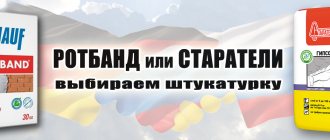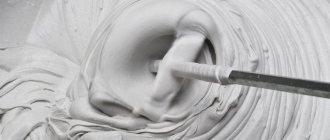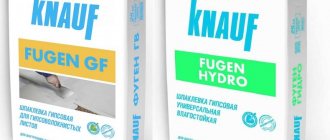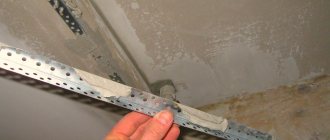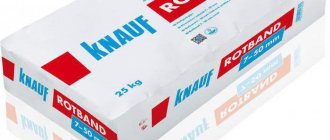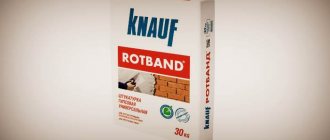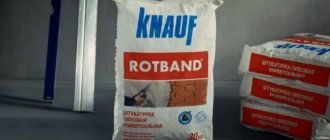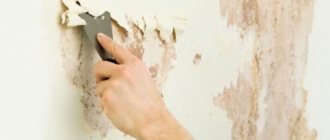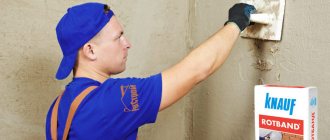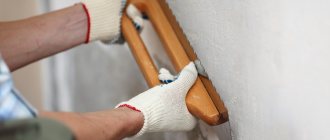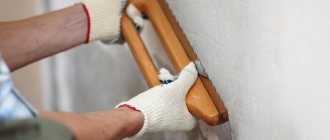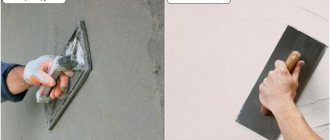How to knead Knauf Start?
Pour one bag (25 kg) of the KNAUF-HP Start dry mixture into a container with clean cold water (14 l) and mix by hand or with a construction mixer until a homogeneous, lump-free mass is obtained. Apply the prepared mortar mixture to the surface within 40 minutes and level it using the rule.
Interesting materials:
How to return a message from the trash? How can I get my old keyboard back? How to return a product after the warranty period? How can I get my downloads back? How to identify maple in spring? How to behave on the stairs? How to behave when meeting a polar bear? How to broadcast on Like? How to dry persimmons in a dryer? How to see through frosted glass?
Composition and scope
The main components of Knauf building materials are a binder - high-quality gypsum, to which plastic modifiers and mineral-based fillers are added.
Depending on the area of production in Russia, the grain size of the composition ranges from 0.5 mm to 1.2 mm, and the colors are white, gray and pink.
Knauf building materials (Golband or Rotband) are intended for manual and machine coating of partitions and ceilings of residential and non-residential rooms.
The dry composition Goldband is used for high-quality leveling of walls in interior spaces for various purposes with normal humidity. The basis for processing is any material: brick, concrete, cement-bonded particle board, expanded polystyrene.
Rotband is also applied to all types of partitions, but the difference from Goldband is its increased moisture resistance, so it is possible to use:
- in the kitchen;
- in the shower;
- on ceilings with smooth concrete surfaces;
If necessary, the composition is applied to the area of application (except for the ceiling) in several layers sequentially, making sure to wait an average of one week for each coating to dry completely.
Building materials delivered to your home and construction site
You can buy building materials in the online store stroymaterialy.ru with delivery and unloading to your home or pickup from our warehouse in Moscow.
Cost of unloading and lifting building materials
Our dear customers, if you are satisfied with our prices for building materials and you decide to purchase them in our store, you can use the service of delivery, unloading and lifting to a floor with an elevator. We can determine the cost of delivery for all services only after placing your order and the address of your facility. Also, the price of delivery depends on some facts: size, weight, length of the material and whether there is a freight elevator.
Cost of lifting building materials to the floor
By freight elevator - 1000 rubles per 1 ton. Without elevator - 1 ruble per 1 kg (1st floor)
We would like you to pay great attention to the fact that not all the material can fit on the freight elevator; in this case, this is all discussed with the manager.
Drying
There should be no drafts or sudden temperature changes in the room where the plaster is dried. Avoid exposing the coating to direct sunlight. In order not to harm it, you should not speed up drying. You can ventilate the room approximately 24 hours after finishing work. This will remove the liquid that is on the plaster material. Typically, Knauf gypsum plaster takes about seven days to dry, in some cases it takes two weeks . This coating can take quite a long time to dry in high humidity conditions.
Who will tell you what is important +
Are Knauf's plaster mixtures different: Grünband, Rotband and Goldband?
If everything is more/less clear with Rotband, then with the rest it’s unclear.
09/06/2006 at 09:40
CHATsky wrote: are Knauf's plaster mixtures different: Grunband, Rotband and Goldband?
If everything is more/less clear with Rotband, then with the rest it’s unclear.
Rotband and goldband plaster based on gypsum for plastering walls and ceilings indoors. Grunband is cement-based and is used for external and internal work. Designed for plastering the surfaces of building facades, walls and ceilings in wet rooms, on bases made of ceramic and silicate bricks, concrete, gas, foam, expanded clay concrete blocks. The difference between rotband and goldband is in the adhesive additives - in rotband there are more of them, in goldband there are fewer. Goldband is designed for plastering on uneven, ribbed surfaces, with an increased adhesion area. Rotband can also be used to plaster on smooth surfaces, such as concrete.
09/06/2006 at 10:40
I got a bag of Eunice gypsum plaster. Previously, I had no business with store-bought plasters, only with putties, I mainly mixed CPS or lime mortar and plastered quite a lot with it. Here in a stupor - the solution does not want to compact, the consistency of cottage cheese sticks to the grater, trowel and spatula, I got all nervous and as a result, an even coating did not work out. The solution was prepared according to the instructions on the bag. Explain how it works. And can it be used as a putty on lime plaster?
09/06/2006 at 10:43
I understand about Goldband. Well, probably with large volumes it allows you to save estimated funds. With volumes of two or three bags, Rotband is not a competitor. And I already found out about Grunband in Knauf - it has thermal insulating granules and is vapor permeable.
09/06/2006 at 12:59
Okay, then what is the difference between VETONIT-KR and VETONIT-Lr+? Both mixtures are sort of like finishing putties. It seems like LR+ cannot be used to putty seams in gypsum board. What is the fundamental difference? What's stronger?
09/06/2006 at 16:29
CHATsky wrote: Okay, then what is the difference between VETONIT-KR and VETONIT-Lr+?
Lr+ is based on a polymer binder, kr-organic, lr can be used on large layers, kr- only on smooth ones, it sags very strongly even in small depressions. At the same time, the body has a strong unpleasant odor, either from dirty foot wraps or from a men's locker room.
CHATsky wrote: Both mixtures seem to be finishing putties. It seems like LR+ cannot be used to putty seams in gypsum board. What is the fundamental difference? What's stronger?
Both of these putties are not intended for sealing joints in gypsum board. Why do you need to know their strength? If the edge and there is nothing to cover the seams with, then dilute the LR+ primer with approximately 50/50 soil/water. But this mixture cannot replace specialized gypsum putties (vetonite silyte, for example).
09/06/2006 at 16:42
michael(S.-Pb) wrote: At the same time, the cr has a strong unpleasant odor, either dirty foot wraps or a men's locker room.
The smell disappears when it dries - it's not scary
09/06/2006 at 17:21
A freshly divorced woman needs to work - then she doesn’t smell
09/07/2006 at 11:34
I used Vetonit-KR last night. I'm in a trance. Why haven't I used it before? There was a third of a bag of Plitonitovskaya gypsum putty left - I puttyed one wall with it. The rest was puttied with Vetonit. Well, just DIFFERENT sensations. Vetonite lays down very smoothly and forgives mistakes (you can smooth out dried areas with a spatula without the appearance of new defects). I liked it very much, the result is excellent. The smell is present, but not very annoying - after drying it completely disappears. . I need to try Lr+. since it allows you to apply thicker layers.
09/08/2006 at 03:02
Andrew_030 wrote: Here in a stupor - the solution does not want to compact, the consistency of cottage cheese sticks to the grater, trowel and spatula, I was all nervous and the result was no even coating. The solution was prepared according to the instructions on the bag.
The working surfaces of the tool must have a flat and smooth surface, i.e. the instrument must be professional and well-maintained. If the work is long (several hours), then the tool must be cleaned periodically. You can also wet the working surface of the same grater or trowel in water (for convenience, so that it doesn’t really stick). Why didn’t it turn out to be an even coating, i.e. they did it by lighthouses or something; Did you take the mixing water from a measuring container or add it by eye, looking at the consistency??
Andrew_030 wrote: Explain how it works.
Yes, in principle, just like with any other plaster
Andrew_030 wrote: And can it be used as a putty on lime plaster?
What for?? There is also one where they respond quite promptly regarding plastering work and mixtures. Good luck
Specifications
The table of material indicators below will help you find out how the building mixtures Rotband differ from Goldband.
| Characteristics | Rotband | Goldband |
| Solution output (l/kg) | 120/100 | 115/120 |
| Cover thickness: minimum / maximum (mm) | 5/50 | 8/30 |
| Setting time (min) | 20-25 | 20 |
| Water consumption for preparing the composition (l/kg) | 0,57 | 0,6 |
| Compressive Strength(MPa) | 4,5 | 4,3 |
| Bean size (grinding) (mm) | up to 1.2 | Up to 1.2 |
| Drying speed of 10 mm thick layer (min) | 45-60 | 45-60 |
| Shelf life in bags (month) | 6 | 6 |
| Temperature range for normal solution handling (°C) | +5 — 30 | +5 — 30 |
| Color | grey, white, pink | grey, white, pink |
| Package weight (kg) | 30, 25, 10, 5 | 30, 25, 10, 5 |
| Thermal conductivity coefficient W/(m×K) | 0,25 | 0,25 |
| Bulk weight (kg/m³) | 730 | 750 |
| Flexural strength (MPa) | 2,1 | 1,9 |
| Density (kg/m³) | 950 | 980 |
As can be seen from the table, both Knauf products are similar in appearance and in their qualities. But still there is a difference. Let's look at their differences.
Rotband contains adhesive ingredients that provide a strong connection to the treated area. Goldband does not have such additives. When labeling products, manufacturers indicate that in the first case it is adhesive plaster with increased adhesion, and in the second case it is a ready-made gypsum mixture.
This is the area of application of the products: Rotband is used for leveling rough and smooth bases of walls and ceilings (concrete only) with a coating thickness of up to 50 mm. Including in rooms with high humidity. The goldband is applied thinner - up to 30 mm only on the bases with which there is better adhesion. Another difference is that it is 30% cheaper than the previous type.
Gypsum plaster Knauf Goldband / Knauf GOLDBAND - review
An inexpensive mixture for plaster with a slight difference from Rotband. Plastic, easy to apply, good results.
We bought an apartment in a new building without finishing, with bare brick walls and windows. We did the repairs ourselves, starting with wiring, ending with heating, screeding, etc. The quality of the project from the developer left much to be desired, and therefore we redesigned our home in our own way so that every meter was used profitably. At work, we usually use Rotband - it’s better, but because of the good discount on Goldband, I took it.
DIFFERENCE BETWEEN ROTBAND AND GOLDBAND:
Both plaster mixtures are based on gypsum, but differ significantly in characteristics. Rotband contains more additives that strengthen the composition of the mixture, due to this the scope of its application has been significantly expanded. In operation, the difference between them is not noticeable; the final surface of the walls is identical. My goal was to plaster the living rooms, which Goldband successfully accomplished.
GYPSUM PLASTER KNAUF AT A GOOD PRICE:
The plaster mixture mixes well with a regular mixer attachment on a drill and does not clump. Good adhesion to brick, easy to apply, easy to level, composition is very plastic. Unlike cement plasters, it is noticeably easier and faster to use. Application time is about 40 minutes. With my crooked hands, aligning the walls with the beacons turned out to be an A the first time. After drying, the surface of the walls was covered with primer, puttied and painted. No cracks.
- Lightweight
- Plastic
- Doesn't crack
- Doesn't drain
- Dries quickly
- Not suitable for the bathroom
Price: 350 RUR / 30 Kg
Max layer thickness: 5 cm
Manufacturer: Knauf, Russia
Result:
I tried to work with different brands and settled on Knauf, and I consider this mixture to be the best in quality for its price. I saved a lot on the purchase with a price difference of about 110 rubles per 30 kg bag.
Great value repair products:
A full-fledged bathroom sink for 1000 rubles. Everyone likes
Apron from a boar for the kitchen. inexpensive and very beautiful
Dulux Bindo 20 - My favorite paint. We've been working with her for 10 years
Rotband (gray-white-pink)
I went into the first store I came across and asked what kind of rotband they had.
- Ours is grey. Real!
- In what sense is it real?! What, white is not real?!
- White has too much plaster in it! It cracks when it dries. (I must admit, I already tried to make a couple of small walls white - nothing cracked)
In general, gray is the real type, but white is not.
It seems to me that this is some kind of nonsense.
But in reality, which one is better to work with? Or does it not matter?
07/29/2011 at 13:55 07/29/2011 at 14:19
The real thing is determined not by color, but by technology and composition. At the Abramtsevo construction market (Moscow, outside the Moscow Ring Road) there is both real and not real, the sellers don’t even hide it. Externally they differ in the paper from which the bags are made. The real one has corrugated and smooth paper, the fake one has regular paper, but with exactly the same pattern. They behave differently at work. The real one is more viscous, it spreads better and the setting time is significantly longer. When casting the partition, I mixed it in half + expanded clay sand. It turned out optimal. No cracks (6 cm thick + reinforcement), the hardness is significantly greater than that of native plaster partitions.
07/29/2011 at 14:46
Thank you I thought that those in the store were “specialists”. I went to Isolux to get a white one (the grey, kind of gloomy).
07/29/2011 at 15:31
You need to look not at the color, but at the certificate and documents for the shipment.
07/29/2011 at 16:29
egal_novice wrote: Thank you! I thought that those in the store were “specialists”. I went to Isolux to get a white one (the grey, kind of gloomy).
07/29/2011 at 17:10
isolux serious guys. the color, as already written, depends on the quarry.
07/29/2011 at 22:05
gans gr wrote: isolux serious guys. the color, as already written, depends on the quarry.
In the Moscow region d.b. only gray. Although your isolux price lists include HP-start and goldband, these plasters are not and will not be available in the Moscow region. This is what they explained to me a month ago at Knauf. But they exist in Ukraine and, apparently, in other regions. M.b. did you bring it?
The Rotband price of 306 rubles is a very good price. Now (or rather, yesterday - I was just picking up a pallet) it was retail at 335-340 from Knauf dealers.
z.y. carefully study the hologram and the time on the bags (so as not to repeat it)
07/29/2011 at 22:26
Viktor__s wrote: In Moscow there is a rotband from Krasnogorsk. And it is only produced there in gray.
Well, yes. The St. Petersburg one is also gray. And recently we took a couple of bags in the store - white. Made in Astrakhan. It is written on the bag that the color does not matter. The Astrakhan one feels very good.
07/29/2011 at 22:42
I had a chance to try Chelyabinsk-gray-pink (we mostly have it), Astrakhan (white), Krasnodar (white). I liked the Krasnodar one the most, it is more flexible even when it starts to set.
07/29/2011 at 22:43
Viktor__s wrote: The price of the rotband is 306 rubles - a very good price.
In Leroy it costs that much.
07/29/2011 at 22:44
Sarge wrote: I liked the Krasnodar one the most in my work
And “Volma-layer” is even better.
07/29/2011 at 22:46
Viktor__s wrote: The price of a rotband is 306 rubles
Happy, we have 358 in Leroy, in other car rentals it’s even more expensive.
07/29/2011 at 22:47
I wanted to try it, but didn't have the chance
07/29/2011 at 23:29
Sarge wrote: Happy, we have 358 in Leroy, other cars are even more expensive.
Delivery to you is expensive
07/30/2011 at 00:32
Sarge wrote: I wanted to try it, but didn’t have the chance
hmm, it didn’t work, however.
07/31/2011 at 14:53
As for Volma, many wrote on the forum that Volma was “weaker”. "Lie"?
07/31/2011 at 18:21
And how! although I didn’t work for Rotband, it seems))))
08/01/2011 at 02:45
- Ours is grey. Real!
- In what sense is it real?! What, white is not real?!
And gray and white and pink are real (if it is not counterfeit, of course) But, for example, a white rotband (popularly known as the Moldavian rotband) is considered to be of worse quality than gray, and it costs less than gray. But nevertheless, the gray one wears off over the years, and the white one stagnates, however, like Pearlfix white glue, it is weaker than the gray one.
On the other hand, perhaps this is all a matter of habit.
Labor without art is barbarism!
08/01/2011 at 02:57
Viktor__s wrote: The price of the rotband is 306 rubles - a very good price. Now (or rather, yesterday - I was just picking up the pallet)
Interesting. Every now and then everyone says, you can’t find a Rotband in Leroy, or you have to wait for weeks to order. My customers searched more than once, and more than one customer, and they searched for more than one week - all in vain. At OBI, a 10 kg rotband costs 175 rubles per bag, so these were already the remains of luxury. I trust my customers. Moreover, both the Knauf tongue-and-groove comb and the rotband and the gypsum board itself temporarily have problems with this, they cannot be found anywhere, I only take them to order. A Rotband bag costs at least 340 rubles if I take 100 bags at once. And here it is on you! A pallet, 40 bags, and even in Leroy? And even for 306 rubles? Very surprising.
Labor without art is barbarism!
08/01/2011 at 03:06
The worker wrote: At least 340 rubles per bag of rotband
There are still cheaper ones here and there. Like
08/01/2011 at 07:55
By the way, the Rotband has really gone up in price, back in April it cost three hundred, but now where I bought it it costs 330.
08/01/2011 at 12:00
Serious, that's for sure. They steal plaster in bags. I paid for 12 bags and loaded them into the trunk. I arrived home - 11. The next day I went and paid for another 8, asking for one bag. The storekeeper is like, let's yell on the phone - oh, sho, where, what are you doing, you have 3 rows of 4, 4 rows of 3, yes, I counted. I really wanted to climb into the tube and hit its snout. Not because of 326 rubles - they called him a liar out of the blue.
08/01/2011 at 12:33
They could have stolen it, or they could have simply not put it in. I always check. although it happened in AUCHAN, I forgot my bag, etc. but there is “small” there. but now they yell everywhere and almost always, it’s certainly disgusting.
01.08.2011 at 13:45
gans gr wrote: they could have stolen it, or they could have simply not put it in. I always check
Yes, of course they just didn’t put it in. They put the first bag in - and there was a hole in it as big as my head. They delayed it and didn't bring a replacement. And there is such a market woman there. grandma I would say.
Well, okay, to hell with it. The main thing is that the plaster is normal
08/01/2011 at 14:07
Well, remind them that this was the case, you still order more. Don’t pay attention to the markets, but it’s better to spend 300 rubles yourself.
08/01/2011 at 14:33
Worker wrote: Moreover, both Knauf tongue-and-groove and rotband and gypsum board itself temporarily have problems with this, can’t be found anywhere, I take it only and only to order. .
Didn’t you try to buy tongue-and-groove comb and GKL directly from Knauf Marketing Krasnogorsk? It’s convenient - from the manufacturer directly. They will ship it to you directly from the factory (from the gates of the factory workshop).
Worker wrote: Interesting. Every now and then everyone says, you can’t find a Rotband in Leroy, or you have to wait for weeks to order. My customers searched more than once, and more than one customer, and they searched for more than one week - all in vain. At OBI, a 10 kg rotband costs 175 rubles per bag, so these were already the remains of luxury. I trust my customers. A Rotband bag costs at least 340 rubles, if I take 100 bags at once. And here it is on you! A pallet, 40 bags, and even in Leroy? And even for 306 rubles? Very surprising.
I wrote: “The Rotband price of 306 rubles is a very good price. Now (or rather, yesterday - I was just picking up a pallet) it retailed from Knauf dealers at 335-340.” I didn’t mention the words “Leroy”. It’s not at all clear why you decided that we were talking about Leroy?
Surface preparation
First you need to determine the temperature in the room. When carrying out finishing work, the temperature should be no more than +30 degrees and no less than +5 degrees, otherwise the coating will be deformed. In this case, finishing work will need to be done again.
In order for the coating to be as durable and strong as possible, dirt and dust should be removed from the base in advance. If there is an old plaster layer, it is also better to clean it off first.
It will be necessary to remove metal elements (for example, screws, nails) from the surface. There can only be chips and cracks on the wall; they should be filled with plaster composition.
The surface can be treated with a primer, which will allow the plaster composition to better adhere to the base. This especially applies to brick and foam concrete surfaces.
Is there an alternative to the rotband?
Gypsum plaster is needed for interior work (layer 15-20mm). All builders, of course, really like the rotband. The plaster is of course good, the only thing that doesn’t please me is the price and the likelihood of counterfeiting, given that you need 300 bags.
At the same time, there are a lot of other cheaper options for gypsum plasters on the market (the same Knauf made HP-Start, like an economy option).
We will plaster blocks made of cellular concrete; in principle, the walls are smooth, but about 2 cm should be applied to the outer walls, because outside plaster 1cm thick.
Recommend cheaper analogues, please. Moreover, the house is countryside, a perfectly mirror surface is not required, but waves and bumps instead of a smooth wall are also not acceptable.
06.12.2009 at 07:52
Renex wrote: We will plaster blocks made of cellular concrete, in principle the walls are smooth, but about 2 cm should be stuck on the outer walls,
It’s not clear: Why do you make the thickness of the plaster layer inside dependent on the thickness of the plaster outside. There are no such requirements. To answer the question, in our area all the inexpensive local plaster is available. plasters are “thin-layer”, that is, they are intended for a layer of up to 2 cm (rotband - up to 5 cm). Such plasters are just for you. For many, the initial adhesion to the base is better than that of Rotband, although you will not feel this from foam concrete. In short, take any and plaster to your health
06.12.2009 at 10:24
You can also start and mp 75 and unis-teplon. t dry mixture m 150- . and Volma-layer. The main thing is primer
06.12.2009 at 10:36
Yes, you can use XP Start. I personally like it better than Rotband. It’s more pleasant to work with and the wall is then immediately ready for further finishing, with certain skills. Besides, the layer you specified (15-20 mm) is just right for this!
12/06/2009 at 10:56
XP Start is an alternative, especially since the layer is up to 2cm.
12/06/2009 at 11:01
Teplon, and more recently Volma, are widespread in Lipetsk. And Rotband has long been of disgusting quality. The best was St. Petersburg gray (KOLPINO)
06.12.2009 at 11:05
For the last three years we have been plastering with Teplon, which is no worse than Rotbant, and the price is lower.
12/06/2009 at 11:27
don't take it as an advertisement. I choose the mixture for the plaster myself.
I stopped there for now. Special plasters for cellular concrete, type
12/06/2009 at 11:33
Used on many objects PLASTER Price (judging by “today’s” price list) 205 RUR/mesh. You can get a discount (or at least free shipping) for your quantity.
12/06/2009 at 11:45
Renex wrote: because. outside plaster 1cm thick
Rotband is used only indoors with normal humidity. On the facade, use not gypsum plaster, but for example: cement-sand
06.12.2009 at 12:37
Gray wrote: it is unclear: Why do you make the thickness of the plaster layer inside dependent on the thickness of the plaster outside.
As I read somewhere, to maintain normal steam/moisture permeability of the walls, make the plaster twice as thick on the inside as on the outside.
The assistant wrote: Rotband is used only indoors with normal humidity. On the facade, use not gypsum plaster, but for example: cement-sand
The outside is already plastered with Knauf Unterputz, 1 cm.
06.12.2009 at 13:39
Renex wrote: As I read somewhere, to maintain normal steam/moisture permeability of the walls, make the plaster twice as thick on the inside as on the outside.
logical, but... This idea could be valid if the mixtures are the same inside and outside, and if there are no plaster finishes. Even a primer greatly changes the permeability of the coating. So, it’s too late to rush around))), you have different plasters on the outside and inside, with different vapor permeability properties. Make a normal thin layer, the minimum necessary and sufficient for leveling. If you soak it with aquastop, for example, the permeability will decrease by about 5 times (IMHO, I won’t give calculations and formulas))). Then there is also painting or vinyl wallpaper.
06.12.2009 at 13:59
I myself am for the reasonable use of gypsum plasters. Room walls can be plastered with Russean plasters, the hallway and kitchen, where the load is higher, can be plastered with rodband, the most critical places, window slopes, possible cracks, door junctions need to be plastered with pofas. For a two-room apartment with an area of 60 sq.m. and an average layer of plaster of 2.5 cm (the total area of plastering is about 200 sq.m.) it takes about 300 bags of mixture. Therefore, a significant part of the cost will be loading and unloading work (the cost of each bag of mixture increases by 25 percent). But most of all you can lose on poorly performed work. Compared to remodeling, the cost of plaster will seem low.
06.12.2009 at 14:04
at a construction site there should not be a mixture of venigrets, but only one. and it’s easier to calculate the volume and you don’t have to think about where to put the 1 remaining bag.
06.12.2009 at 14:08
We have a country cottage, so it’s easier to bring all 300 bags at once. Another problem is that I can’t find HP Start in Moscow at normal prices. In Yekaterinburg it’s 150-160, and in Moscow it’s under 250 rubles per bag. Or is this the norm?
06.12.2009 at 14:15
Moreover, it’s a country house, a perfectly mirror surface is not required
This is what you think now, until you come across it. if possible, it should be done at least according to GOST, the guest concept> ideally mirror surface
is absent, but there are many other parameters by which the quality of work is assessed.
there should be no venigret from mixtures at a construction site
Gone are the days when there was no choice. I am for the reasonable use of materials. For example, why do you need a highly durable and at the same time plastic pofas on the wall behind the furniture. or a light and fragile plaster at the entrance door to the apartment. Simplicity is worse than theft. I will also surprise you with the fact that paints are used with different properties depending on the purpose of the room. If the brigade consists of semi-literate Tajiks... it is not surprising that the plaster and the pofas will end up in the same batch. We are discussing a normal situation here. Hire a bookkeeper and an accounting worker if you can’t cope with the increased assortment. Threat...all IMHO, nothing personal.
Technological sequence of finishing work
Calculation of materials
The consumption rates for Goldband or Rotband mixtures are indicated on the bag and amount to an average of 8.5 kg per 1 m² of treated surface with a coating thickness of up to 12 mm. If you take a package weighing 30 kg, it is easy to calculate that it will be enough for a surface area of 3.5 m².
The costs of building materials also depend on the quality of foundation preparation.
Preparatory work:
- Remove all defects, dust, dirt, moisture and corrosion from the finishing area before applying the solution. It is required to ensure that the temperature of the treatment area is not lower than + 5° C.
- Applying a primer before applying finishing material to increase adhesion.
- Marking the work site and installing beacons with dowels or mortar. With sufficient experience and even partitions, they are not installed.
- Installation of profiles (corner) with a frequency of 200–400 mm from the corners to the center of the room.
Plastering works:
- Making a solution. Pour two buckets of water into the container per 30 kg of Knauf product. Add one third of the contents of the package there and mix thoroughly with an electric mixer to form a mass without lumps. Pour in the remaining material and repeat the procedure. Wait 5 minutes, then stir the contents of the tank again.
- Coating the prepared bases with the solution should be carried out no later than 20-25 minutes after preparing the composition.
If Rotband is used, then apply it to the ceiling covering with a motion towards you. For both types of Knauf building materials when finishing walls, there is the same method of applying the composition from bottom to top, followed by leveling the plane with zigzag movements using the -rule.
Coating of smooth partitions is carried out using a special mesh, which should be placed one third into a layer of plaster.
Leveling the surface
After 45-60 minutes from the moment of covering the wall or ceiling with the composition, the dried cover must be leveled with a spatula or rule, removing the excess layer and filling in the defects. Protruding places on slopes and in the corners of the room must be cut off with a construction plane.
Grouting the finishing area
Further work consists of preparing the base for wallpapering or painting. After the previous finishing stage, you should wait 15 minutes, then moisten the surface with water and use a felt float to carefully remove all defects remaining after the previous treatment.
Smoothing the base
The next stage is the final preparation of partitions and ceilings for final finishing. Smooth the surfaces with wide strokes using a float until a matte surface is obtained, onto which it is easy to paste wallpaper, waiting until the leveling area is completely dry.
To prepare walls and ceilings for subsequent high-quality painting, the above procedure must be repeated after the solution has dried.
What to choose Rotband or Volma?
The modern market for finishing materials includes dozens of different types of products, among which there is a huge range of plasters. Each item of this product has certain characteristics, and although many plaster mixtures are offered as universal ones, in absolute terms multifunctional solutions suitable for all occasions do not yet exist. Therefore, when starting a renovation or starting the finishing work stage of building a house, the owners ask themselves: which plaster is better, Rotband or Volma. And yet, the concept of “best plaster” should be considered in the prism of specific purposes and conditions of use.
This even applies to materials that are related in scope, technical and operational properties, such as the above-mentioned compositions made on the basis of binder gypsum - Rotband or Volma-Sloy. Therefore, in order to make a choice, let’s take a closer look at each type of this plaster product in more detail.
High-tech gypsum plasters: comparison of mixtures
Gypsum dry plasters are environmentally friendly finishing materials, which is an important factor in interior decoration. Volma and Rotband are made from several components: gypsum, filler and polymer additives.
Rotband is produced by Russian factories using German technology from the Knauf company and differs in viscosity, size class and shade. The prepared solution is used to level the base surface of wall and ceiling structures made of concrete, brickwork, cement-concrete slabs, and expanded polystyrene. Among the positive aspects of the mixture, experts note:
- good adhesion indicator;
- plastic;
- no shrinkage after drying of the plastered surface, high degree of resistance to cracking.
Due to the resulting smooth and even plastering surface, the walls do not require subsequent mandatory puttying and allow the finishing to be applied by gluing wallpaper, painting or tiling. Rotband is different in that the solution is applied only by hand and is used exclusively for interior work. The plasticity of the mass allows even craftsmen without sufficient experience to work with it.
Volma gypsum plaster compositions include several modifications, the Volma-Sloy version is used for manual work, and the Volma-Sloy-MN mixture is intended for machine plastering. The solution is used for leveling, and since the mixture is finely ground, the surface of the coating is smoothed to the state of soft putty, and the walls acquire impeccable evenness. They are coated with paints or decorated with wallpaper. The material is valued for the following qualities:
- non-shrink drying;
- compatibility and excellent adhesion to any surfaces;
- resistance to cracking and delamination.
Thus, if Rotband and Volma are compared, they are almost identical in technical and operational characteristics. However, in the Volma assortment, the manufacturer pays attention to waterproof mixtures, therefore, for leveling walls in rooms with high humidity, this brand of mixture is preferred.
Many plasterers note that the mortar prepared on the basis of the Volma dry mixture is softer and easier to work with manually, but the productivity of the work is considered higher when using Rotband.
Repair and restoration work: which is better Rotband or Volma
Both types of plaster are used when engaged in restoration work and the manufacture of various types of decorative elements for premises. Due to the soft, homogeneous and elastic mixture of gypsum plasters, they have become widely used in interior decoration.
The material is used to create relief panels, ceiling moldings and other decorative elements. Such products dry quickly and adhere perfectly to flat surfaces of the ceiling and walls. In this area of application, Rotband or Volma are identical materials, and the choice in favor of one of them is exclusively individual and subjective.
The only thing that numerous reviews from professional and home craftsmen warn about is that Volma plaster, produced at the Chelyabinsk plant’s facilities, is not always of high quality, and they manage to counterfeit the more expensive Rotband.
What is the difference between Rotband and Volma?
As evidenced by the characteristics of both gypsum plasters, the materials have almost identical qualities and service life, and equally meet installation, environmental and operational requirements. However, Rotband, having appeared on the Russian market back in the 90s, had great advertising support, and therefore is well known to a wide range of consumers.
A significant difference in the cost of materials with almost the same consumption often plays a primary role in the choice of dry plaster. Rotband is more expensive, so by buying Volma, the consumer can save a significant amount of money.
This is probably where the materials differ. Otherwise, if the work is performed with a high-quality original plaster mixture, the technology and manufacturer’s recommendations are followed, the result will be the same. Therefore, the decision on the issue of Rotband or Volma-Layer: which is better to purchase, rests at the discretion of the master.
